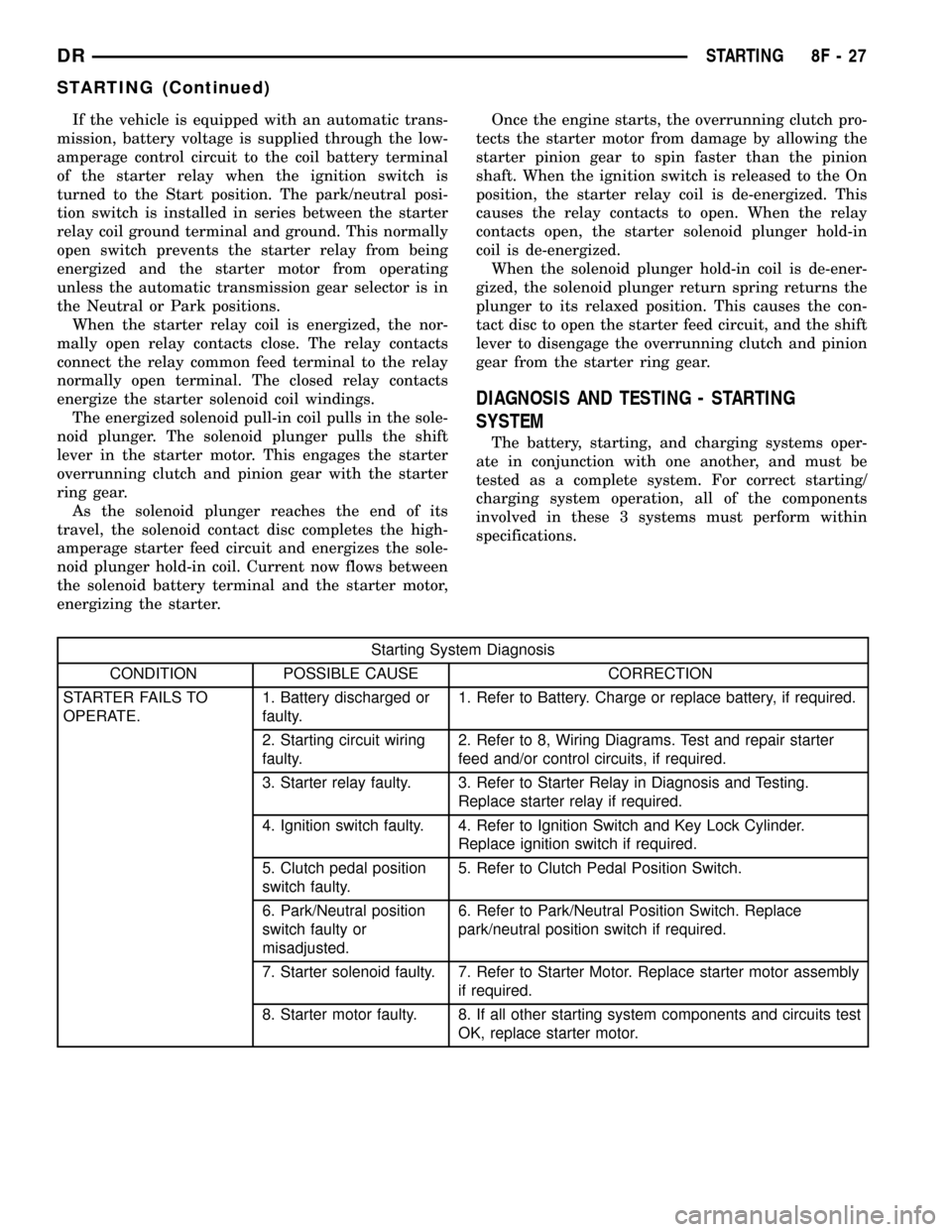Charging system operation DODGE RAM 1500 1998 2.G User Guide
[x] Cancel search | Manufacturer: DODGE, Model Year: 1998, Model line: RAM 1500, Model: DODGE RAM 1500 1998 2.GPages: 2627
Page 457 of 2627

STARTING
TABLE OF CONTENTS
page page
STARTING
DESCRIPTION.........................26
OPERATION...........................26
DIAGNOSIS AND TESTING - STARTING
SYSTEM............................27
SPECIFICATIONS
STARTING SYSTEM...................31
SPECIFICATIONS - TORQUE - STARTING
SYSTEM............................32
STARTER MOTOR
DIAGNOSIS AND TESTING - STARTER
MOTOR .............................32REMOVAL.............................33
INSTALLATION.........................34
STARTER MOTOR RELAY
DESCRIPTION.........................35
OPERATION...........................36
DIAGNOSIS AND TESTING - STARTER RELAY . 36
REMOVAL.............................37
INSTALLATION.........................37
STARTING
DESCRIPTION
The starting system consists of:
²Starter relay
²Starter motor (including an integral starter sole-
noid)
Other components to be considered as part of start-
ing system are:
²Battery
²Battery cables
²Ignition switch and key lock cylinder
²Clutch pedal position switch (manual transmis-
sion)
²Park/neutral position switch (automatic trans-
mission)
²Wire harnesses and connections.
The Battery, Starting, and Charging systems oper-
ate in conjunction with one another, and must be
tested as a complete system. For correct operation of
starting/charging systems, all components used in
these 3 systems must perform within specifications.
When attempting to diagnose any of these systems, it
is important that you keep their interdependency in
mind.
The diagnostic procedures used in each of these
groups include the most basic conventional diagnostic
methods, to the more sophisticated On-Board Diag-
nostics (OBD) built into the Powertrain Control Mod-
ule (PCM). Use of an induction-type milliampere
ammeter, volt/ohmmeter, battery charger, carbon pile
rheostat (load tester), and 12-volt test lamp may be
required.Certain starting system components are monitored
by the PCM and may produce a Diagnostic Trouble
Code (DTC). Refer to Diagnostic Trouble Codes in
Emission Control for a list of codes.
OPERATION
The starting system components form two separate
circuits. A high-amperage feed circuit that feeds the
starter motor between 150 and 350 amperes (700
amperes - diesel engine), and a low-amperage control
circuit that operates on less than 20 amperes. The
high-amperage feed circuit components include the
battery, the battery cables, the contact disc portion of
the starter solenoid, and the starter motor. The low-
amperage control circuit components include the igni-
tion switch, the clutch pedal position switch (manual
transmission), the park/neutral position switch (auto-
matic transmission), the starter relay, the electro-
magnetic windings of the starter solenoid, and the
connecting wire harness components.
If the vehicle is equipped with a manual transmis-
sion, it has a clutch pedal position switch installed in
series between the ignition switch and the coil bat-
tery terminal of the starter relay. This normally open
switch prevents the starter relay from being ener-
gized when the ignition switch is turned to the Start
position, unless the clutch pedal is depressed. This
feature prevents starter motor operation while the
clutch disc and the flywheel are engaged. The starter
relay coil ground terminal is always grounded on
vehicles with a manual transmission.
8F - 26 STARTINGDR
Page 458 of 2627

If the vehicle is equipped with an automatic trans-
mission, battery voltage is supplied through the low-
amperage control circuit to the coil battery terminal
of the starter relay when the ignition switch is
turned to the Start position. The park/neutral posi-
tion switch is installed in series between the starter
relay coil ground terminal and ground. This normally
open switch prevents the starter relay from being
energized and the starter motor from operating
unless the automatic transmission gear selector is in
the Neutral or Park positions.
When the starter relay coil is energized, the nor-
mally open relay contacts close. The relay contacts
connect the relay common feed terminal to the relay
normally open terminal. The closed relay contacts
energize the starter solenoid coil windings.
The energized solenoid pull-in coil pulls in the sole-
noid plunger. The solenoid plunger pulls the shift
lever in the starter motor. This engages the starter
overrunning clutch and pinion gear with the starter
ring gear.
As the solenoid plunger reaches the end of its
travel, the solenoid contact disc completes the high-
amperage starter feed circuit and energizes the sole-
noid plunger hold-in coil. Current now flows between
the solenoid battery terminal and the starter motor,
energizing the starter.Once the engine starts, the overrunning clutch pro-
tects the starter motor from damage by allowing the
starter pinion gear to spin faster than the pinion
shaft. When the ignition switch is released to the On
position, the starter relay coil is de-energized. This
causes the relay contacts to open. When the relay
contacts open, the starter solenoid plunger hold-in
coil is de-energized.
When the solenoid plunger hold-in coil is de-ener-
gized, the solenoid plunger return spring returns the
plunger to its relaxed position. This causes the con-
tact disc to open the starter feed circuit, and the shift
lever to disengage the overrunning clutch and pinion
gear from the starter ring gear.
DIAGNOSIS AND TESTING - STARTING
SYSTEM
The battery, starting, and charging systems oper-
ate in conjunction with one another, and must be
tested as a complete system. For correct starting/
charging system operation, all of the components
involved in these 3 systems must perform within
specifications.
Starting System Diagnosis
CONDITION POSSIBLE CAUSE CORRECTION
STARTER FAILS TO
OPERATE.1. Battery discharged or
faulty.1. Refer to Battery. Charge or replace battery, if required.
2. Starting circuit wiring
faulty.2. Refer to 8, Wiring Diagrams. Test and repair starter
feed and/or control circuits, if required.
3. Starter relay faulty. 3. Refer to Starter Relay in Diagnosis and Testing.
Replace starter relay if required.
4. Ignition switch faulty. 4. Refer to Ignition Switch and Key Lock Cylinder.
Replace ignition switch if required.
5. Clutch pedal position
switch faulty.5. Refer to Clutch Pedal Position Switch.
6. Park/Neutral position
switch faulty or
misadjusted.6. Refer to Park/Neutral Position Switch. Replace
park/neutral position switch if required.
7. Starter solenoid faulty. 7. Refer to Starter Motor. Replace starter motor assembly
if required.
8. Starter motor faulty. 8. If all other starting system components and circuits test
OK, replace starter motor.
DRSTARTING 8F - 27
STARTING (Continued)
Page 552 of 2627

OPERATION
The voltage gauge gives an indication to the vehi-
cle operator of the electrical system voltage. This
gauge is controlled by the instrument cluster circuit
board based upon cluster programming and elec-
tronic messages received by the cluster from the
Powertrain Control Module (PCM) on vehicles
equipped with a gasoline engine, or from the Engine
Control Module (ECM) on vehicles equipped with a
diesel engine over the Programmable Communica-
tions Interface (PCI) data bus. The voltage gauge is
an air core magnetic unit that receives battery cur-
rent on the instrument cluster electronic circuit
board through the fused ignition switch output (run-
start) circuit whenever the ignition switch is in the
On or Start positions. The cluster is programmed to
move the gauge needle back to the left end of the
scale after the ignition switch is turned to the Off
position. The instrument cluster circuitry controls
the gauge needle position and provides the following
features:
²System Voltage Message- Each time the clus-
ter receives a system voltage message from the PCM
or ECM indicating the system voltage is between
about 9.5 volts and about 15 volts, the gauge needle
is moved to the relative voltage position on the gauge
scale.
²System Voltage Low (Charge Fail) Message
- Each time the cluster receives three consecutive
messages from the PCM or ECM indicating the elec-
trical system voltage is less than about 9 volts
(charge fail condition), the gauge needle is moved to
the graduation on the far left end of the gauge scale
and the check gauges indicator is illuminated. The
gauge needle remains at the far left end of the gauge
scale and the check gauges indicator remains illumi-
nated until the cluster receives a single message
from the PCM or ECM indicating the electrical sys-
tem voltage is greater than about 9.5 volts (but less
than about 15.5 volts), or until the ignition switch is
turned to the Off position, whichever occurs first. On
vehicles equipped with the optional diesel engine, the
ECM is programmed to restrict the voltage gauge
needle to a position above the graduation on the far
left end of the gauge scale and suppress the check
engine indicator operation until after the engine
intake manifold air heater has completed a pre-heat
or post-heat cycle.²System Voltage High Message- Each time
the cluster receives three consecutive messages from
the PCM or ECM indicating the electrical system
voltage is greater than about 15.5 volts, the gauge
needle is moved to the graduation on the far right
end of the gauge scale and the check gauges indica-
tor is illuminated. The gauge needle remains at the
right end of the gauge scale and the check gauges
indicator remains illuminated until the cluster
receives a message from the PCM or ECM indicating
the electrical system voltage is less than about 15.0
volts (but greater than about 9.5 volts), or until the
ignition switch is turned to the Off position, which-
ever occurs first.
²Communication Error- If the cluster fails to
receive a system voltage message, it will hold the
gauge needle at the last indication for about five sec-
onds or until the ignition switch is turned to the Off
position, whichever occurs first. After five seconds,
the cluster will move the gauge needle to the far left
end of the gauge scale.
²Actuator Test- Each time the cluster is put
through the actuator test, the voltage gauge needle
will be swept to several calibration points on the
gauge scale in a prescribed sequence in order to con-
firm the functionality of the gauge and the cluster
control circuitry.
On vehicles with a gasoline engine, the PCM con-
tinually monitors the system voltage to control the
generator output. On vehicles with a diesel engine,
the ECM continually monitors the system voltage to
control the generator output. The PCM or ECM then
sends the proper system voltage messages to the
instrument cluster. For further diagnosis of the volt-
age gauge or the instrument cluster circuitry that
controls the gauge, (Refer to 8 - ELECTRICAL/IN-
STRUMENT CLUSTER - DIAGNOSIS AND TEST-
ING). If the instrument cluster turns on the check
gauges indicator due to a charge fail or voltage high
condition, it may indicate that the charging system
requires service. For proper diagnosis of the charging
system, the PCM, the ECM, the PCI data bus, or the
electronic message inputs to the instrument cluster
that control the voltage gauge, a DRBIIItscan tool is
required. Refer to the appropriate diagnostic infor-
mation.
DRINSTRUMENT CLUSTER 8J - 43
VOLTAGE GAUGE (Continued)
Page 558 of 2627

Instrument Cluster transmits a message via J1850
informing the the FCM. The FCM will then turn off
the headlamps, park lamps and fog lamps. This fea-
ture (load shed) prevents the vehicle battery from
being discharged when the vehicle lights have been
left ON.
HEADLAMP TIME DELAY SYSTEM
The headlamp time delay system is activated by
turning the headlamps ON (high or low beam) while
the engine is running, turning the ignition switch
OFF, and then turning the headlamp switch OFF
within 45 seconds. The system will not activate if
more than 45 seconds elapse between ignition switch
OFF and headlamp switch OFF. The FCM will allow
the headlamps to remain ON for 60 seconds (config-
urable) before they automatically turn off (If the key
is in the ignition during the headlamp time delay
mode, then the headlamps including panel dimming
will be ON).
LAMP OUTAGE
If one or more of the following lamps (Low and/or
High beams, Brake and/or Turn Signal) are out, then
a ªlamps outº indicator located in the cluster will
illuminate.
OPTICAL HORN/HIGH BEAMS
When the multiplexed multifunction switch is
pulled to the first detent (optical horn) signal, the
headlamps are ON, the Instrument Cluster shall
send a message via J1850 to the FCM to turn on the
headlamps drivers to illuminate all four filaments
(Low and High beams). When the multifunction
switch is pulled to the second detent (high beam) sig-
nal and the headlamps are ON, the Instrument Clus-
ter shall send a message via J1850 to the FCM to
turn on the headlamps drivers. The High Beams are
illuminated and the Low Beams and Fog Lamps (if
ON) are extinguished. If the headlamps were in the
high beam configuration when power was removedfrom the headlamps, the headlamps will return to
their last state prior to being shut off.
DIAGNOSIS AND TESTING - LAMPS/LIGHTING
- EXTERIOR
WARNING: EYE PROTECTION SHOULD BE USED
WHEN SERVICING GLASS COMPONENTS. PER-
SONAL INJURY CAN RESULT.
CAUTION: Do not touch the glass of halogen bulbs
with fingers or other possibly oily surface, reduced
bulb life will result. Do not use bulbs other than
those indicated in the Bulb Application table. Dam-
age to lamp and/or Daytime Running Lamp Module
can result. Do not use fuses, circuit breakers or
relays having greater amperage value than indi-
cated on the fuse panel or in the Owners Manual.
When a vehicle experiences problems with the
headlamp system, verify the condition of the battery
connections, fuses, charging system, headlamp bulbs,
wire connectors, relay, multifunction switch, and
headlamp switch. Refer to the appropriate wiring
information.
Each vehicle is equipped with various lamp assem-
blies. A good ground is necessary for proper lighting
operation. Grounding is provided by the lamp socket
when it comes in contact with the metal body, or
through a separate ground wire.
When changing lamp bulbs check the socket for
loose pin connections and corrosion. Repair as neces-
sary.
When it is necessary to remove components to ser-
vice another, it should not be necessary to apply
excessive force or bend a component to remove it.
Before damaging a trim component, verify hidden
fasteners or captured edges are not holding the com-
ponent in place.
DRLAMPS/LIGHTING - EXTERIOR 8L - 3
LAMPS/LIGHTING - EXTERIOR (Continued)
Page 2533 of 2627

STANDARD PROCEDURE - REFRIGERANT
SYSTEM SERVICE EQUIPMENT
WARNING: EYE PROTECTION MUST BE WORN
WHEN SERVICING AN AIR CONDITIONING REFRIG-
ERANT SYSTEM. TURN OFF (ROTATE CLOCKWISE)
ALL VALVES ON THE EQUIPMENT BEING USED
BEFORE CONNECTING TO, OR DISCONNECTING
FROM THE REFRIGERANT SYSTEM. FAILURE TO
OBSERVE THESE WARNINGS MAY RESULT IN PER-
SONAL INJURY.
WARNING: REVIEW THE WARNINGS AND CAU-
TIONS IN THE FRONT OF THIS SECTION BEFORE
PERFORMING THE FOLLOWING OPERATION (Refer
to 24 - HEATING & AIR CONDITIONING/PLUMBING -
WARNING) and (Refer to 24 - HEATING & AIR CON-
DITIONING/PLUMBING - CAUTION).
When servicing the air conditioning system, a
R-134a refrigerant recovery/recycling/charging sta-
tion that meets SAE Standard J2210 must be used
(Fig. 2). Contact an automotive service equipment
supplier for refrigerant recovery/recycling/charging
equipment. Refer to the operating instructions sup-
plied by the equipment manufacturer for proper care
and use of this equipment.
A manifold gauge set may be needed with some
recovery/recycling/charging equipment (Fig. 3). The
service hoses on the gauge set being used should
have manual (turn wheel), or automatic back-flow
valves at the service port connector ends. This will
prevent refrigerant from being released into the
atmosphere.
MANIFOLD GAUGE SET CONNECTIONS
CAUTION: Do not use an R-12 manifold gauge set
on an R-134a system. The refrigerants are not com-
patible and system damage will result.
LOW PRESSURE GAUGE HOSE The low pressure
hose (Blue with Black stripe) attaches to the low side
service port. This service port is located on the suc-
tion line between the accumulator outlet port and the
A/C compressor.
HIGH PRESSURE GAUGE HOSE The high pres-
sure hose (Red with Black stripe) attaches to the
high side service port. This service port is located on
the discharge line near the A/C compressor. On this
model, an A/C pressure transducer is installed onto
the high pressure service port. A/C high side pres-
sures can be read using a DRBIIItscan tool. Refer to
Body Diagnostic Procedures.
RECOVERY/RECYCLING/EVACUATION/CHARG-
ING HOSE The center manifold hose (Yellow, or
White, with Black stripe) is used to recover, evacu-
ate, and charge the refrigerant system. When the low
or high pressure valves on the manifold gauge set
are opened, the refrigerant in the system will escape
through this hose.
Fig. 2 Refrigerant Recovery/Recycling Station -
Typical
1 - R-134a REFRIGERANT STATION
Fig. 3 MANIFOLD GAUGE SET - TYPICAL
1 - HIGH PRESSURE GAUGE
2 - VALVE
3 - VACUUM/REFRIGERANT HOSE (YELLOW W/ BLACK STRIPE)
4 - HIGH PRESSURE HOSE (RED W/ BLACK STRIPE)
5 - LOW PRESSURE HOSE (BLUE W/ BLACK STRIPE)
6 - VALVE
7 - LOW PRESSURE GAUGE
24 - 46 PLUMBINGDR
PLUMBING (Continued)
Page 2534 of 2627

STANDARD PROCEDURE - REFRIGERANT
RECOVERY
WARNING: REVIEW THE WARNINGS AND CAU-
TIONS IN THE FRONT OF THIS SECTION BEFORE
PERFORMING THE FOLLOWING OPERATION (Refer
to 24 - HEATING & AIR CONDITIONING/PLUMBING -
WARNING) and (Refer to 24 - HEATING & AIR CON-
DITIONING/PLUMBING - CAUTION).
A R-134a refrigerant recovery/recycling/charging
station that meets SAE Standard J2210 must be
used to recover the refrigerant from an R-134a refrig-
erant system. Refer to the operating instructions sup-
plied by the equipment manufacturer for the proper
care and use of this equipment.
STANDARD PROCEDURE - REFRIGERANT
SYSTEM EVACUATE
NOTE: Special effort must be used to prevent mois-
ture from entering the A/C system oil. Moisture in
the oil is very difficult to remove and will cause a
reliability problem with the compressor.
If a compressor designed to use R-134a refrigerant
is left open to the atmosphere for an extended period
of time. It is recommended that the refrigerant oil be
drained and replaced with new oil or a new compres-
sor be used. This will eliminate the possibility of con-
taminating the refrigerant system.
If the refrigerant system has been open to the
atmosphere, it must be evacuated before the system
can be filled. Moisture and air mixed with the refrig-
erant will raise the compressor head pressure above
acceptable operating levels. This will reduce the per-
formance of the air conditioner and damage the com-
pressor. Moisture will boil at near room temperature
when exposed to vacuum. To evacuate the refrigerant
system:
NOTE: When connecting the service equipment
coupling to the line fitting, verify that the valve of
the coupling is fully closed. This will reduce the
amount of effort required to make the connection.
(1) Recover the refrigerant system (Refer to 24 -
HEATING & AIR CONDITIONING/PLUMBING -
STANDARD PROCEDURE).
(2) Connect a suitable charging station, refrigerant
recovery machine or a manifold gauge set with vac-
uum pump and refrigerant recovery equipment.
(3) Open the suction and discharge valves and
start the vacuum pump. The vacuum pump should
run a minimum of 45 minutes prior to charge to
eliminate all moisture in system. When the suction
gauge reads -88 kPa (- 26 in. Hg) vacuum or greaterfor 30 minutes, close all valves and turn off vacuum
pump. If the system fails to reach specified vacuum,
the refrigerant system likely has a leak that must be
corrected. If the refrigerant system maintains speci-
fied vacuum for at least 30 minutes, start the vac-
uum pump, open the suction and discharge valves.
Then allow the system to evacuate an additional 10
minutes.
(4) Close all valves. Turn off and disconnect the
vacuum pump.
(5) Charge the refrigerant system (Refer to 24 -
HEATING & AIR CONDITIONING/PLUMBING -
STANDARD PROCEDURE).
STANDARD PROCEDURE - REFRIGERANT
SYSTEM CHARGE
WARNING: REVIEW SAFETY PRECAUTIONS AND
WARNINGS IN THIS GROUP BEFORE CHARGING
THE REFRIGERANT SYSTEM.
AVOID BREATHING A/C REFRIGERANT AND LUBRI-
CANT VAPOR OR MIST. EXPOSURE MAY IRRITATE
EYES, NOSE AND THROAT. USE ONLY APPROVED
SERVICE EQUIPMENT MEETING SAE REQUIRE-
MENTS TO DISCHARGE R-134a SYSTEM. IF ACCI-
DENTAL SYSTEM DISCHARGE OCCURS,
VENTILATE WORK AREA BEFORE RESUMING SER-
VICE.
R-134a SERVICE EQUIPMENT OR VEHICLE A/C
SYSTEM SHOULD NOT BE PRESSURE TESTED OR
LEAK TESTED WITH COMPRESSED AIR. MIXTURE
OF AIR and R-134a CAN BE COMBUSTIBLE AT ELE-
VATED PRESSURES. THESE MIXTURES ARE
POTENTIALLY DANGEROUS AND MAY RESULT IN
FIRE OR EXPLOSION CAUSING INJURY OR PROP-
ERTY DAMAGE.
CAUTION: Do not overcharge refrigerant system, as
excessive compressor head pressure can cause
noise and system failure.
CAUTION: A small amount of refrigerant oil is
removed from the A/C system each time the refrig-
erant system is recovered and evacuated. Before
charging the A/C system, you MUST replenish any
oil lost during the recovery process. Refer the
equipment manufacturer instructions for more infor-
mation.
The procedure below should be used to fill the
refrigerant charge in the air conditioning system.
This A/C system does not have or use a sight glass to
check or charge the system.
DRPLUMBING 24 - 47
PLUMBING (Continued)
Page 2535 of 2627

After the system has been tested for leaks and
evacuated, a refrigerant (R-134a) charge can be
injected into the system.
NOTE: When connecting the service equipment
coupling to the line fitting, verify that the valve of
the coupling is fully closed. This will reduce the
amount of effort required to make the connection.
(1) If using a separate vacuum pump close all
valves before disconnecting pump. Connect manifold
gauge set to the A/C service ports.
NOTE: Always refer to the underhood HVAC Speci-
fication label for the refrigerant fill level of the vehi-
cle being serviced.
(2) Measure refrigerant (refer to capacities). Refer
to the instructions provided with the equipment
being used.
(3) Verify engine is shut off. Open the suction and
discharge valves. Open the charge valve to allow the
refrigerant to flow into the system. When the trans-
fer of refrigerant has stopped, close the suction and
discharge valve.
(4) If all of the charge did not transfer from the
dispensing device, put vehicle controls into the fol-
lowing mode:
²Automatic transmission in park or manual
transmission in neutral
²Engine at idle
²A/C mode control set to outside air
²A/C mode control set to panel mode
²A/C temperature control set to full cool
²Blower motor control set on highest speed
²Vehicle windows closed
If the A/C compressor does not engage, test the
compressor clutch control circuit and correct any fail-
ure (Refer to 8 - ELECTRICAL/WIRING DIAGRAM
INFORMATION - DIAGNOSIS AND TESTING).
(5) Open the suction valve to allow the remaining
refrigerant to transfer to the system.
WARNING: TAKE CARE NOT TO OPEN THE DIS-
CHARGE (HIGH-PRESSURE) VALVE AT THIS TIME.
(6) Close all valves and test the A/C system perfor-
mance.
(7) Disconnect the charging station or manifold
gauge set. Install the service port caps.
REFRIGERANT CHARGE CAPACITY
The R-134a refrigerant system charge capacity for
this vehicle can be found on the underhood HVAC
specfication tag.
A/C COMPRESSOR
DESCRIPTION
DESCRIPTION - A/C COMPRESSOR
The A/C system on models equipped with the 5.9L
engine use a Sanden SD-7 reciprocating swash plate-
type compressor. This compressor has a fixed dis-
placement of 165 cubic centimeter (10.068 cubic
inches) and has both the suction and discharge ports
located on the cylinder head.
The A/C system on models equipped with the 3.7L,
4.7L and 5.7L engines use a Denso 10S17 reciprocat-
ing swash plate-type compressor. This compressor
has a fixed displacement of 170 cubic centimeter and
has both the suction and discharge ports located on
the cylinder head.
A label identifying the use of R-134a refrigerant is
located on both A/C compressors.
DESCRIPTION - HIGH PRESSURE RELIEF
VALVE
A high pressure relief valve is located on the com-
pressor cylinder head, which is on the rear of the
compressor. This mechanical valve is designed to
vent refrigerant from the system to protect against
damage to the compressor and other system compo-
nents, caused by condenser air flow restriction or an
overcharge of refrigerant.
OPERATION
OPERATION - A/C COMPRESSOR
The A/C compressor is driven by the engine
through an electric clutch, drive pulley and belt
arrangement. The compressor is lubricated by refrig-
erant oil that is circulated throughout the refrigerant
system with the refrigerant.
The compressor draws in low-pressure refrigerant
vapor from the evaporator through its suction port. It
then compresses the refrigerant into a high-pressure,
high-temperature refrigerant vapor, which is then
pumped to the condenser through the compressor dis-
charge port.
The compressor cannot be repaired. If faulty or
damaged, the entire compressor assembly must be
replaced. The compressor clutch, pulley and clutch
coil are available for service.
OPERATION - HIGH PRESSURE RELIEF VALVE
The high pressure relief valve vents the system
when a discharge pressure of 3445 to 4135 kPa (500
to 600 psi) or above is reached. The valve closes
24 - 48 PLUMBINGDR
PLUMBING (Continued)
Page 2536 of 2627

when a minimum discharge pressure of 2756 kPa
(400 psi) is reached.
The high pressure relief valve vents only enough
refrigerant to reduce the system pressure, and then
re-seats itself. The majority of the refrigerant is con-
served in the system. If the valve vents refrigerant, it
does not mean that the valve is faulty.
The high pressure relief valve is a factory-cali-
brated unit. The valve cannot be adjusted or
repaired, and must not be removed or otherwise dis-
turbed. The valve is only serviced as a part of the
compressor assembly.
DIAGNOSIS AND TESTING - A/C COMPRESSOR
When investigating an air conditioning related
noise, you must first know the conditions under
which the noise occurs. These conditions include:
weather, vehicle speed, transmission in gear or neu-
tral, engine speed, engine temperature, and any
other special conditions. Noises that develop during
air conditioning operation can often be misleading.
For example: What sounds like a failed front bearing
or connecting rod, may be caused by loose bolts, nuts,
mounting brackets, or a loose compressor clutch
assembly.
Drive belts are speed sensitive. At different engine
speeds and depending upon belt tension, belts can
develop noises that are mistaken for a compressor
noise. Improper belt tension can cause a misleading
noise when the compressor clutch is engaged, which
may not occur when the compressor clutch is disen-
gaged. Check the serpentine drive belt condition and
tension as described in Cooling before beginning this
procedure.
(1) Select a quiet area for testing. Duplicate the
complaint conditions as much as possible. Switch the
compressor on and off several times to clearly iden-
tify the compressor noise. Listen to the compressor
while the clutch is engaged and disengaged. Probe
the compressor with an engine stethoscope or a long
screwdriver with the handle held to your ear to bet-
ter localize the source of the noise.
(2) Loosen all of the compressor mounting hard-
ware and retighten. Tighten the compressor clutch
mounting nut. Be certain that the clutch coil is
mounted securely to the compressor, and that the
clutch plate and rotor are properly aligned and have
the correct air gap (Refer to 24 - HEATING & AIR
CONDITIONING/CONTROLS/A/C COMPRESSOR
CLUTCH - INSTALLATION).
(3) To duplicate a high-ambient temperature condi-
tion (high head pressure), restrict the air flow
through the condenser. Install a manifold gauge set
or a DRBIIItscan tool to be certain that the dis-
charge pressure does not exceed 2760 kPa (400 psi).(4) Check the refrigerant system plumbing for
incorrect routing, rubbing or interference, which can
cause unusual noises. Also check the refrigerant lines
for kinks or sharp bends that will restrict refrigerant
flow, which can cause noises (Refer to 24 - HEATING
& AIR CONDITIONING/PLUMBING - STANDARD
PROCEDURE).
(5) If the noise is from opening and closing of the
high pressure relief valve, recover, evacuate and
recharge the refrigerant system (Refer to 24 - HEAT-
ING & AIR CONDITIONING/PLUMBING - STAN-
DARD PROCEDURE), (Refer to 24 - HEATING &
AIR CONDITIONING/PLUMBING - STANDARD
PROCEDURE - REFRIGERANT SYSTEM EVACU-
ATE) and (Refer to 24 - HEATING & AIR CONDI-
TIONING/PLUMBING - STANDARD PROCEDURE -
REFRIGERANT SYSTEM CHARGE). If the high
pressure relief valve still does not seat properly,
replace the compressor (Refer to 24 - HEATING &
AIR CONDITIONING/PLUMBING/A/C COMPRES-
SOR - REMOVAL).
(6) If the noise is from liquid slugging on the suc-
tion line, replace the accumulator (Refer to 24 -
HEATING & AIR CONDITIONING/PLUMBING/AC-
CUMULATOR - REMOVAL) and check the refriger-
ant oil level and the refrigerant system charge (Refer
to 24 - HEATING & AIR CONDITIONING/PLUMB-
ING/REFRIGERANT OIL - STANDARD PROCE-
DURE) (Refer to 24 - HEATING & AIR
CONDITIONING/PLUMBING/ACCUMULATOR -
REMOVAL). If after replacing the accumulator the
slugging condition still exists then replace the com-
pressor.(Refer to 24 - HEATING & AIR CONDITION-
ING/PLUMBING/A/C COMPRESSOR - REMOVAL).
(7) If the liquid slugging condition continues fol-
lowing accumulator replacement, replace the com-
pressor and repeat Step 1.
REMOVAL
WARNING: REVIEW THE WARNINGS AND CAU-
TIONS IN THE FRONT OF THIS SECTION BEFORE
PERFORMING THE FOLLOWING OPERATION (Refer
to 24 - HEATING & AIR CONDITIONING/PLUMBING -
WARNING) and (Refer to 24 - HEATING & AIR CON-
DITIONING/PLUMBING - CAUTION).
NOTE: The A/C compressor may be removed and
repositioned without disconnecting the refrigerant
lines or discharging the refrigerant system. Dis-
charging is not necessary if servicing the compres-
sor clutch, clutch coil, engine, engine cylinder head
or the generator.
(1) Recover the refrigerant from the refrigerant
system (Refer to 24 - HEATING & AIR CONDITION-
DRPLUMBING 24 - 49
A/C COMPRESSOR (Continued)
Page 2590 of 2627

BALL JOINT - DIAGNOSIS AND TESTING,
LOWER.........................2-19,2-34
BALL JOINT - DIAGNOSIS AND TESTING,
UPPER..........................2-27,2-36
BALL JOINT - INSTALLATION, LOWER . 2-20,2-35
BALL JOINT - INSTALLATION, UPPER.....2-36
BALL JOINT - REMOVAL, LOWER.....2-19,2-35
BALL JOINT - REMOVAL, UPPER.........2-36
BAND OPERATION - DIAGNOSIS AND
TESTING, AIR TESTING
TRANSMISSION CLUTCH.............21-144
BANDS - ADJUSTMENT...............21-195
BANDS - DESCRIPTION...............21-194
BANDS - OPERATION................21-194
BAR - DESCRIPTION, STABILIZER........2-24
BAR - DESCRIPTION, TORSION..........2-26
BAR - INSTALLATION, STABILIZER....2-25,2-40
BAR - INSTALLATION, TORSION..........2-27
BAR - INSTALLATION, TRACK...........19-38
BAR - OPERATION, STABILIZER..........2-25
BAR - OPERATION, TORSION............2-26
BAR - REMOVAL, STABILIZER.......2-25,2-39
BAR - REMOVAL, TORSION.............2-26
BAR - REMOVAL, TRACK..............19-38
BAR CROSS MEMBER BUSHING -
INSTALLATION, TORSION...............2-15
BAR CROSSMEMBER BUSHING -
REMOVAL, TORSION...................2-13
BASE BRAKE, SPECIFICATIONS...........5-10
BASE BRAKE SYSTEM - DIAGNOSIS AND
TESTING.............................5-2
BASE BRAKES, SPECIAL TOOLS...........5-5
BASECOAT/CLEARCOAT FINISH -
DESCRIPTION.......................23-73
BATTERIES - STANDARD PROCEDURE,
RKE TRANSMITTER...................8N-8
BATTERY - DESCRIPTION...............8F-7
BATTERY - DIAGNOSIS AND TESTING.....8F-7
BATTERY CABLES - DESCRIPTION.......8F-14
BATTERY CABLES - DIAGNOSIS AND
TESTING...........................8F-15
BATTERY CABLES - INSTALLATION.......8F-17
BATTERY CABLES - OPERATION.........8F-15
BATTERY CABLES - REMOVAL..........8F-16
BATTERY CHARGING - STANDARD
PROCEDURE.........................8F-8
BATTERY HOLDDOWN - DESCRIPTION....8F-14
BATTERY HOLDDOWN - INSTALLATION . . . 8F-14
BATTERY HOLDDOWN - OPERATION.....8F-14
BATTERY HOLDDOWN - REMOVAL.......8F-14
BATTERY SYSTEM - CLEANING...........8F-5
BATTERY SYSTEM - DESCRIPTION........8F-1
BATTERY SYSTEM - DIAGNOSIS AND
TESTING............................8F-2
BATTERY SYSTEM - INSPECTION.........8F-5
BATTERY SYSTEM - OPERATION.........8F-2
BATTERY SYSTEM - SPECIFICATIONS......8F-6
BATTERY SYSTEM SPECIAL TOOLS,
SPECIAL TOOLS......................8F-7
BATTERY TEMPERATURE SENSOR -
DESCRIPTION.......................8F-21
BATTERY TEMPERATURE SENSOR -
INSTALLATION.......................8F-21
BATTERY TEMPERATURE SENSOR -
OPERATION.........................8F-21
BATTERY TEMPERATURE SENSOR -
REMOVAL..........................8F-21
BATTERY TESTER - STANDARD
PROCEDURE, USING MICRO 420........8F-12
BATTERY TRAY - DESCRIPTION.........8F-17
BATTERY TRAY - INSTALLATION.........8F-18
BATTERY TRAY - OPERATION...........8F-17
BATTERY TRAY - REMOVAL............8F-17
BEAM INDICATOR - DESCRIPTION, HIGH . . 8J-28
BEAM INDICATOR - OPERATION, HIGH....8J-28
BEARING - ADJUSTMENTS, CENTER.......3-9
BEARING - FITTING - STANDARD
PROCEDURE, CRANKSHAFT MAIN . . 9-134,9-207
BEARING - INSTALLATION, CENTER........3-9
BEARING - INSTALLATION, CLUTCH
RELEASE............................6-10
BEARING - INSTALLATION, HUB
..........2-32
BEARING - INSTALLATION, OUTPUT
SHAFT FRONT
......................21-216
BEARING - INSTALLATION, OUTPUT
SHAFT REAR
.......................21-217
BEARING - INSTALLATION, PILOT
........6-12
BEARING - REMOVAL, CENTER
...........3-9BEARING - REMOVAL, CLUTCH RELEASE . . . 6-9
BEARING - REMOVAL, HUB.............2-31
BEARING - REMOVAL, OUTPUT SHAFT
FRONT............................21-216
BEARING - REMOVAL, OUTPUT SHAFT
REAR.............................21-216
BEARING - REMOVAL, PILOT............6-11
BEARING AND CRANKSHAFT JOURNAL
CLEARANCE - STANDARD
PROCEDURE, CONNECTING ROD........9-272
BEARING CLEARANCE - STANDARD
PROCEDURE, MAIN...................9-274
BEARING FITTING - STANDARD
PROCEDURE, CONNECTING ROD........9-129
BEARING FITTING, STANDARD
PROCEDURE - CONNECTING ROD........9-49
BEARING FITTING, STANDARD
PROCEDURE - MAIN...................9-44
BEARINGS - INSPECTION, CRANKSHAFT
MAIN.........................9-135,9-208
BEARINGS - INSTALLATION, AXLE . . 3-125,3-153,
3-44,3-95
BEARINGS - INSTALLATION, CAMSHAFT . . 9-271
BEARINGS - INSTALLATION,
DIFFERENTIAL CASE . . . 3-106,3-134,3-161,3-48,
3-75
BEARINGS - REMOVAL, AXLE . 3-125,3-152,3-43,
3-95
BEARINGS - REMOVAL, CAMSHAFT......9-268
BEARINGS - REMOVAL, DIFFERENTIAL
CASE............3-105,3-134,3-161,3-48,3-75
BELT - 3.7L / 4.7L - INSTALLATION,
DRIVE................................7-26
BELT - 3.7L / 4.7L - REMOVAL, DRIVE.....7-26
BELT - 5.9L DIESEL - INSTALLATION,
DRIVE..............................7-29
BELT - 5.9L DIESEL - REMOVAL, DRIVE....7-29
BELT / CHAIN COVER(S) -
INSTALLATION, TIMING...........9-171,9-81
BELT / CHAIN COVER(S) - REMOVAL,
TIMING........................9-170,9-81
BELT - DIAGNOSIS AND TESTING,
ACCESSORY DRIVE................7-24,7-27
BELT - INSTALLATION, FRONT CENTER
SEAT ..............................8O-31
BELT - REMOVAL, FRONT CENTER SEAT . . 8O-30
BELT & RETRACTOR - INSTALLATION,
FRONT CENTER SEAT.................8O-29
BELT & RETRACTOR - INSTALLATION,
REAR CENTER SEAT..................8O-45
BELT & RETRACTOR - INSTALLATION,
REAR OUTBOARD SEAT...............8O-47
BELT & RETRACTOR - REMOVAL, FRONT
CENTER SEAT.......................8O-29
BELT & RETRACTOR - REMOVAL, REAR
CENTER SEAT.......................8O-44
BELT & RETRACTOR - REMOVAL, REAR
OUTBOARD SEAT....................8O-46
BELT BUCKLE - INSTALLATION, FRONT
OUTBOARD SEAT....................8O-38
BELT BUCKLE - REMOVAL, FRONT
OUTBOARD SEAT....................8O-37
BELT MOLDING - INSTALLATION, FRONT
DOOR INNER........................23-93
BELT MOLDING - INSTALLATION, FRONT
DOOR OUTER.......................23-93
BELT MOLDING - INSTALLATION, REAR
DOOR INNER........................23-94
BELT MOLDING - INSTALLATION, REAR
DOOR OUTER.......................23-94
BELT MOLDING - REMOVAL, FRONT
DOOR INNER........................23-93
BELT MOLDING - REMOVAL, FRONT
DOOR OUTER.......................23-92
BELT MOLDING - REMOVAL, REAR
DOOR INNER........................23-94
BELT MOLDING - REMOVAL, REAR
DOOR OUTER.......................23-93
BELT SWITCH - DESCRIPTION, SEAT.....8O-51
BELT SWITCH - DIAGNOSIS AND
TESTING, SEAT
......................8O-51
BELT SWITCH - OPERATION, SEAT
.......8O-51
BELT TENSION REDUCER -
DESCRIPTION, SEAT
..................8O-53
BELT TENSION REDUCER - DIAGNOSIS
AND TESTING, SEAT
..................8O-54
BELT TENSION REDUCER - OPERATION,
SEAT
..............................8O-54BELT TENSIONER - 3.7L / 4.7L -
DESCRIPTION........................7-21
BELT TENSIONER - 3.7L / 4.7L -
INSTALLATION........................7-22
BELT TENSIONER - 3.7L / 4.7L -
OPERATION..........................7-21
BELT TENSIONER - 3.7L / 4.7L -
REMOVAL...........................7-21
BELT TENSIONER - 5.9L DIESEL -
DESCRIPTION........................7-23
BELT TENSIONER - 5.9L DIESEL -
INSTALLATION........................7-24
BELT TENSIONER - 5.9L DIESEL -
OPERATION..........................7-23
BELT TENSIONER - 5.9L DIESEL -
REMOVAL...........................7-23
BELT TENSIONER - DESCRIPTION, SEAT . . 8O-52
BELT TENSIONER - OPERATION, SEAT....8O-53
BELT TENSIONER-5.7L - DESCRIPTION....7-22
BELT TENSIONER-5.7L - INSTALLATION....7-23
BELT TENSIONER-5.7L - OPERATION......7-22
BELT TENSIONER-5.7L - REMOVAL.......7-22
BELT TURNING LOOP ADJUSTER -
INSTALLATION, SEAT.................8O-55
BELT TURNING LOOP ADJUSTER -
REMOVAL, SEAT.....................8O-55
BELT/CHAIN AND SPROCKETS -
INSPECTION, TIMING.............9-174,9-84
BELT/CHAIN AND SPROCKETS -
INSTALLATION, TIMING...........9-176,9-85
BELT/CHAIN AND SPROCKETS -
REMOVAL, TIMING.................9-172,9-83
BEZEL - INSTALLATION, CLUSTER.......23-49
BEZEL - INSTALLATION, INSTRUMENT
PANEL CENTER......................23-57
BEZEL - INSTALLATION, INSTRUMENT
PANEL DRIVER SIDE..................23-58
BEZEL - INSTALLATION, INSTRUMENT
PANEL HEADLAMP SWITCH............23-56
BEZEL - REMOVAL, CLUSTER...........23-49
BEZEL - REMOVAL, INSTRUMENT PANEL
CENTER............................23-57
BEZEL - REMOVAL, INSTRUMENT PANEL
DRIVER SIDE........................23-58
BEZEL - REMOVAL, INSTRUMENT PANEL
HEADLAMP SWITCH..................23-56
BIN - INSTALLATION, STORAGE.........23-61
BIN - INSTALLATION, UNDER SEAT
STORAGE...........................23-80
BIN - REMOVAL, STORAGE.............23-61
BIN - REMOVAL, UNDER SEAT STORAGE . . 23-80
BIN COVERING - INSTALLATION, UNDER
SEAT STORAGE......................23-80
BIN COVERING - REMOVAL, UNDER
SEAT STORAGE......................23-80
BIN LATCH - INSTALLATION, UNDER
SEAT STORAGE......................23-80
BIN LATCH - REMOVAL, UNDER SEAT
STORAGE...........................23-80
BIN LID - INSTALLATION, UNDER SEAT
STORAGE...........................23-80
BIN LID - REMOVAL, UNDER SEAT
STORAGE...........................23-80
BLADE - DESCRIPTION, WIPER.........8R-18
BLADE - INSTALLATION, WIPER.........8R-20
BLADE - OPERATION, WIPER...........8R-19
BLADE - REMOVAL, WIPER............8R-19
BLEEDING - STANDARD PROCEDURE......5-31
BLEEDING - STANDARD PROCEDURE,
ABS BRAKE..........................5-46
BLEEDING - STANDARD PROCEDURE,
MANUAL.............................5-5
BLEEDING - STANDARD PROCEDURE,
MASTER CYLINDER...................5-26
BLEEDING - STANDARD PROCEDURE,
PRESSURE...........................5-5
BLEND DOOR - INSTALLATION..........24-27
BLEND DOOR - REMOVAL.............24-27
BLEND DOOR ACTUATOR -
DESCRIPTION.......................24-17
BLEND DOOR ACTUATOR -
INSTALLATION.......................24-18
BLEND DOOR ACTUATOR - OPERATION
. . . 24-17
BLEND DOOR ACTUATOR - REMOVAL
....24-17
BLOCK - CLEANING, ENGINE
. . 9-128,9-205,9-39
BLOCK - DESCRIPTION, BLOWER
MOTOR RESISTOR
...................24-18
BLOCK - DESCRIPTION, ENGINE
.....9-128,9-38
DRINDEX 3
Description Group-Page Description Group-Page Description Group-Page
Page 2593 of 2627

CASE - NV271 - DESCRIPTION,
TRANSFER.........................21-447
CASE - NV271 - DIAGNOSIS AND
TESTING, TRANSFER.................21-448
CASE - NV271 - DISASSEMBLY,
TRANSFER.........................21-450
CASE - NV271 - INSPECTION, TRANSFER . 21-459
CASE - NV271 - INSTALLATION,
TRANSFER.........................21-473
CASE - NV271 - OPERATION, TRANSFER . 21-448
CASE - NV271 - REMOVAL, TRANSFER . . 21-450
CASE - NV273 - ASSEMBLY, TRANSFER . . 21-556
CASE - NV273 - CLEANING, TRANSFER . . 21-554
CASE - NV273 - DESCRIPTION,
TRANSFER.........................21-542
CASE - NV273 - DIAGNOSIS AND
TESTING, TRANSFER.................21-543
CASE - NV273 - DISASSEMBLY,
TRANSFER.........................21-544
CASE - NV273 - INSPECTION, TRANSFER . 21-554
CASE - NV273 - INSTALLATION,
TRANSFER.........................21-568
CASE - NV273 - OPERATION, TRANSFER . 21-543
CASE - NV273 - REMOVAL, TRANSFER . . 21-544
CASE BEARINGS - INSTALLATION,
DIFFERENTIAL.....3-106,3-134,3-161,3-48,3-75
CASE BEARINGS - REMOVAL,
DIFFERENTIAL.....3-105,3-134,3-161,3-48,3-75
CASE CONTROL MODULE -
DESCRIPTION, TRANSFER.............8E-16
CASE CONTROL MODULE - OPERATION,
TRANSFER..........................8E-16
CASE, NV241 GENII - TRANSFER.......21-438
CASE, NV241/NV243 - TRANSFER......21-439
CASE, NV243 - TRANSFER......21-505,21-506
CASE, NV244 GENII - TRANSFER.......21-535
CASE, NV271 - TRANSFER............21-473
CASE NV271/NV273, SPECIAL TOOLS -
TRANSFER...................21-474,21-569
CASE, NV273 - TRANSFER............21-568
CASE SKID PLATE - INSTALLATION,
TRANSFER..........................13-26
CASE SKID PLATE - REMOVAL,
TRANSFER..........................13-26
CASTER ADJUSTMENT - STANDARD
PROCEDURE, CAMBER..................2-4
CASTER AND TOE ADJUSTMENT -
STANDARD PROCEDURE, CAMBER........2-4
CATALYTIC CONVERTER - DESCRIPTION . . . 11-6
CATALYTIC CONVERTER - OPERATION.....11-6
CATCH - INSTALLATION, LATCH STRIKER
/ SECONDARY.......................23-48
CATCH - REMOVAL, LATCH STRIKER /
SECONDARY........................23-47
CAUTION - A/C SYSTEM...............24-43
CAUTION, HALF SHAFT.................3-20
CAUTION, INTERIOR..................23-62
CENTER - DESCRIPTION, ELECTRONIC
VEHICLE INFO.......................8M-7
CENTER - DIAGNOSIS AND TESTING,
ELECTRONIC VEHICLE INFORMATION.....8M-8
CENTER - INSTALLATION, ELECTRONIC
VEHICLE INFO.......................8M-9
CENTER & LEFT OUTBOARD -
INSTALLATION......................8O-50
CENTER & LEFT OUTBOARD - REMOVAL
. . 8O-48
CENTER - OPERATION, ELECTRONIC
VEHICLE INFO
.......................8M-7
CENTER - REMOVAL, ELECTRONIC
VEHICLE INFO
.......................8M-9
CENTER ANCHOR & RIGHT OUTBOARD -
INSTALLATION
......................8O-50
CENTER ANCHOR & RIGHT OUTBOARD -
REMOVAL
..........................8O-49
CENTER ARMREST / SEAT BACK -
INSTALLATION
.......................23-77
CENTER ARMREST / SEAT BACK -
REMOVAL
..........................23-76
CENTER BEARING - ADJUSTMENTS
........3-9
CENTER BEARING - INSTALLATION
........3-9
CENTER BEARING - REMOVAL
............3-9
CENTER BEZEL - INSTALLATION,
INSTRUMENT PANEL
..................23-57
CENTER BEZEL - REMOVAL,
INSTRUMENT PANEL
..................23-57
CENTER HIGH MOUNTED STOP LAMP -
INSTALLATION
.......................8L-11CENTER HIGH MOUNTED STOP LAMP -
REMOVAL..........................8L-11
CENTER HIGH MOUNTED STOP LAMP
UNIT - INSTALLATION.................8L-11
CENTER HIGH MOUNTED STOP LAMP
UNIT - REMOVAL....................8L-11
CENTER PROGRAMMING - STANDARD
PROCEDURE, ELECTRONIC VEHICLE
INFORMATION.......................8M-8
CENTER SEAT - INSTALLATION..........23-76
CENTER SEAT - REMOVAL.............23-75
CENTER SEAT BACK HINGE -
INSTALLATION.......................23-79
CENTER SEAT BACK HINGE - REMOVAL . . . 23-78
CENTER SEAT BACK INERTIA HINGE
COVER - INSTALLATION...............23-77
CENTER SEAT BACK INERTIA HINGE
COVER - REMOVAL...................23-77
CENTER SEAT BACK LID - INSTALLATION . 23-79
CENTER SEAT BACK LID - REMOVAL.....23-79
CENTER SEAT BELT - INSTALLATION,
FRONT.............................8O-31
CENTER SEAT BELT - REMOVAL, FRONT . . 8O-30
CENTER SEAT BELT & RETRACTOR -
INSTALLATION, FRONT................8O-29
CENTER SEAT BELT & RETRACTOR -
INSTALLATION, REAR.................8O-45
CENTER SEAT BELT & RETRACTOR -
REMOVAL, FRONT....................8O-29
CENTER SEAT BELT & RETRACTOR -
REMOVAL, REAR....................8O-44
CENTER SEAT CUSHION - INSTALLATION . . . 23-79
CENTER SEAT CUSHION - REMOVAL.....23-79
CENTER SEAT CUSHION COVER -
INSTALLATION.......................23-79
CENTER SEAT CUSHION COVER -
REMOVAL..........................23-79
CENTERING - STANDARD PROCEDURE,
CLOCKSPRING......................8O-19
CERTIFICATION LABEL - DESCRIPTION,
VEHICLE.........................Intro.-11
CHAIN COVER(S) - INSTALLATION,
TIMING BELT....................9-171,9-81
CHAIN COVER(S) - REMOVAL, TIMING
BELT ..........................9-170,9-81
CHAIN WEAR - STANDARD PROCEDURE,
MEASURING TIMING..................9-167
CHAIN WEAR, STANDARD PROCEDURE -
MEASURING TIMING...................9-77
CHAIN/TENSIONER - DESCRIPTION,
TIMING............................9-229
CHAIN/TENSIONER - OPERATION,
TIMING............................9-229
CHANNEL - INSTALLATION, GLASS RUN . . 23-22,
23-31
CHANNEL - REMOVAL, GLASS RUN . 23-21,23-30
CHARGE - STANDARD PROCEDURE,
REFRIGERANT SYSTEM...............24-47
CHARGE AIR COOLER AND PLUMBING -
CLEANING..........................11-17
CHARGE AIR COOLER AND PLUMBING -
DESCRIPTION.......................11-16
CHARGE AIR COOLER AND PLUMBING -
INSPECTION........................11-17
CHARGE AIR COOLER AND PLUMBING -
INSTALLATION.......................11-17
CHARGE AIR COOLER AND PLUMBING -
OPERATION
.........................11-16
CHARGE AIR COOLER AND PLUMBING -
REMOVAL
..........................11-17
CHARGE AIR COOLER SYSTEM - LEAKS
- DIAGNOSIS AND TESTING
............11-16
CHARGING - DESCRIPTION
.............8F-19
CHARGING - OPERATION
..............8F-19
CHARGING - STANDARD PROCEDURE,
BATTERY
............................8F-8
CHARGING SYSTEM - DIAGNOSIS AND
TESTING
...........................8F-19
CHARGING SYSTEM - SPECIFICATIONS,
TORQUE - GENERATOR
................8F-20
CHART - SPECIFICATIONS, TORQUE
........5-8
CHART, SPECIFICATIONS - TORQUE
.......5-46
CHART, SPECIFICATIONS - TORQUE
.....19-19,
19-23,19-35,19-42
CHART, SPECIFICATIONS - TORQUE
. . 2-10,2-29,
2-42
CHART, SPECIFICATIONS - TORQUE
......22-13CHARTS - DIAGNOSIS AND TESTING,
DIAGNOSIS........................21-145
CHARTS - DIAGNOSIS AND TESTING,
SMOKE DIAGNOSIS...................9-236
CHECK - STANDARD PROCEDURE,
COOLANT LEVEL......................7-17
CHECK - STANDARD PROCEDURE, FLUID
LEVEL......................21-202,21-366
CHECK - STANDARD PROCEDURE, OIL
PUMP VOLUME.....................21-387
CHECK CABLE - INSTALLATION.........23-15
CHECK CABLE - REMOVAL.............23-15
CHECK GAUGES INDICATOR -
DESCRIPTION.......................8J-21
CHECK GAUGES INDICATOR -
OPERATION.........................8J-21
CHECK VALVE - DESCRIPTION...........8R-7
CHECK VALVE - INSTALLATION..........8R-8
CHECK VALVE - OPERATION.............8R-8
CHECK VALVE - REMOVAL..............8R-8
CHILD RESTRAINT ANCHOR -
DESCRIPTION.......................8O-15
CHILD RESTRAINT ANCHOR -
INSTALLATION......................8O-18
CHILD RESTRAINT ANCHOR -
OPERATION.........................8O-17
CHILD RESTRAINT ANCHOR - REMOVAL . . 8O-17
CHIME WARNING SYSTEM -
DESCRIPTION........................8B-1
CHIME WARNING SYSTEM - DIAGNOSIS
AND TESTING........................8B-3
CHIME WARNING SYSTEM - OPERATION . . . 8B-1
CIGAR LIGHTER OUTLET -
DESCRIPTION.....................8W-97-2
CIGAR LIGHTER OUTLET - DIAGNOSIS
AND TESTING.....................8W-97-2
CIGAR LIGHTER OUTLET - OPERATION . 8W-97-2
CIRCUIT - DIAGNOSIS AND TESTING,
AMBIENT TEMPERATURE SENSOR......8M-10
CIRCUIT - OPERATION, FUEL DRAIN.....14-67
CIRCUIT ACTUATION TEST MODE -
DESCRIPTION........................25-1
CIRCUIT FUNCTIONS - DESCRIPTION . . 8W-01-6
CIRCUIT INFORMATION - DESCRIPTION . 8W-01-5
CIRCUIT SENSE - DESCRIPTION,
IGNITION...........................8E-10
CIRCUIT SENSE - OPERATION, IGNITION . . 8E-11
CIRCUITS - OPERATION, NON-
MONITORED.........................25-8
CLAMPS - DESCRIPTION, HOSE...........7-3
CLAMPS - OPERATION, HOSE.............7-5
CLEANING/REVERSE FLUSHING -
STANDARD PROCEDURE, COOLING
SYSTEM............................7-17
CLEARANCE - STANDARD PROCEDURE,
CONNECTING ROD BEARING AND
CRANKSHAFT JOURNAL...............9-272
CLEARANCE - STANDARD PROCEDURE,
MAIN BEARING......................9-274
CLEARANCE LAMP - INSTALLATION, CAB . 8L-12
CLEARANCE LAMP - REMOVAL, CAB.....8L-11
CLOCKSPRING - DESCRIPTION.........8O-18
CLOCKSPRING - INSTALLATION.........8O-21
CLOCKSPRING - OPERATION...........8O-19
CLOCKSPRING - REMOVAL............8O-20
CLOCKSPRING CENTERING - STANDARD
PROCEDURE........................8O-19
CLUSTER - ASSEMBLY, INSTRUMENT....8J-15
CLUSTER - DESCRIPTION, INSTRUMENT . . . 8J-2
CLUSTER - DIAGNOSIS AND TESTING,
INSTRUMENT........................8J-10
CLUSTER - DISASSEMBLY, INSTRUMENT . . 8J-14
CLUSTER - INSTALLATION, INSTRUMENT . 8J-16
CLUSTER - OPERATION, INSTRUMENT.....8J-6
CLUSTER - REMOVAL, INSTRUMENT.....8J-14
CLUSTER BEZEL - INSTALLATION........23-49
CLUSTER BEZEL - REMOVAL...........23-49
CLUTCH - 5.9L DIESEL - DESCRIPTION,
FAN DRIVE VISCOUS...................7-52
CLUTCH - 5.9L DIESEL - OPERATION,
FAN DRIVE VISCOUS...................7-52
CLUTCH - ASSEMBLY, FRONT..........21-207
CLUTCH - ASSEMBLY, LOW/REVERSE . . . 21-385
CLUTCH - ASSEMBLY, REAR
...........21-249
CLUTCH - CLEANING, LOW/REVERSE
....21-385
CLUTCH - CLEANING, REAR
...........21-248
CLUTCH - DESCRIPTION, FRONT
.......21-205
CLUTCH - DESCRIPTION, OVERDRIVE
. . . 21-217
6 INDEXDR
Description Group-Page Description Group-Page Description Group-Page